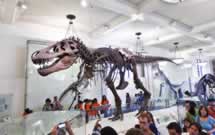No longer do students fill out worksheets during museum trips–today’s spaces are going digital

Museums are a popular field trip destination, but as learning becomes more digital, more and more museums are offering digital learning programs designed to engage students and give them enhanced educational experiences.
During an Alliance for Excellent Education webinar, Barry Joseph, the associate director for digital learning at the American Museum of Natural History (AMNH) in New York City, offered an overview of how digital learning programs are taking root in museums.
AMNH’s digital learning program grew out of a MacArthur Foundation grant that resulted in a framework of connected learning, which focuses on what digital media can enable youth to do, especially when those students are able to learn about their passions and interests, Joseph said.
(Next page: Five digital learning strategies at AMNH)
AMNH encourages students to learn about science with their peers and with real-world science educators and museum staff in a variety of ways:
1. Last fall, the museum conducted a program in which students played games with scientists in order to pique their interest in different areas of science.
“This has been a really exciting, rich area for us to explore,” Joseph said. “They learned how to think critically about how games can be designed to teach.”
After students played the game, museum staff gave them information about upcoming exhibits and associated learning materials, and tasked students with creating their own games–both physical and app-based–focused on the upcoming exhibits.
“For us, it was a great experiment to see what happens when we use games to teach,” Joseph said.
2. Museum staff also use Minecraft with students.
“It means so many different things to so many people. For us, what it meant was an opportunity to think about how to create something to relate to our exhibits,” Joseph said.
Last year, AMNH had an exhibit about food and food production, so museum staff created a Minecraft game about growing and trading food, which students played before experiencing the museum’s exhibit. Students went back to the Minecraft game and automatically applied what they learned in the museum to their Minecraft games.
One of Minecraft’s main benefits is museum staff’s ability to use it to teach new content to young people, Joseph said.
3. Students also use 3D printers to create objects that relate to subjects that they have studied and explored in the museum.
They return to their classes and spread that knowledge and share what they’ve created, which helps to engage peers.
4. Digital badges are in use at AMNH as well.
“We don’t have grades we give to young people–no one would expect to get grades coming through a program like this, and many informal learning programs are similar,” Joseph said. This is where digital badges come in.
“Badges give us an opportunity to not only give youth feedback about places where we think they’re achieving the educational goals we’ve set out for them, but it puts them in charge,” he said.
5. The museum runs a program that helps train teachers to go into schools and bring physical and digital resources from the museum back into classrooms. It also offers a graduate program and a program for urban schools.
Additional educator resources include internships, seminars, professional development workshops, and more, all designed to help educators connect students to digital learning experiences, both at the museum and in the classroom.
Other museums across the country are creating similar digital environments for students and teachers. Stay tuned for a list of museum resources for educators.
- Friday 5: Universal Design for Learning - April 19, 2024
- Educators love their edtech, but want more training - April 18, 2024
- Friday 5: College and career readiness - April 12, 2024


Comments are closed.